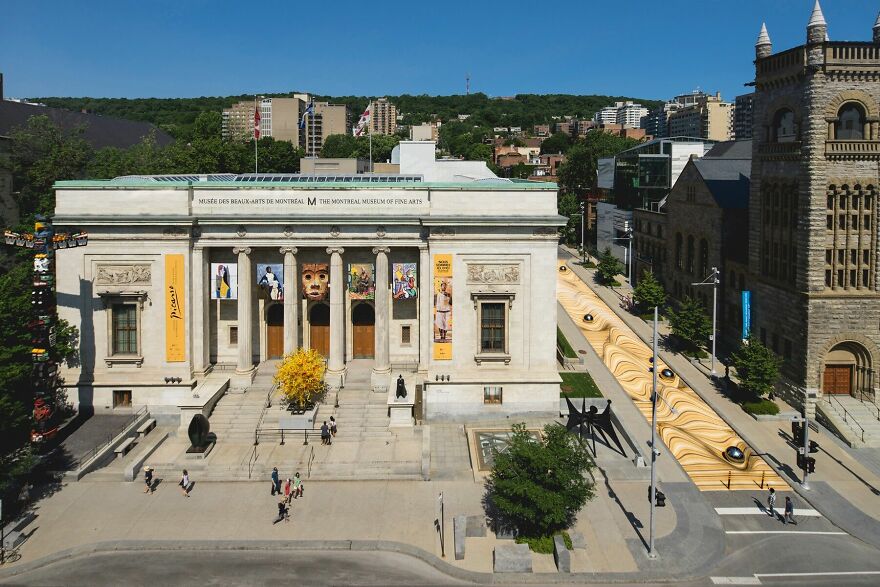
Optical Illusion Transforms A Street In Montreal Into Wavy Sand Dunes
Interview With ArtistIn Star Wars, Obi-Wan Kenobi once said “Your eyes can deceive you, don’t trust them.” And it seems that nothing represents that as well as the artwork “Moving Dunes” created by the Canadian architecture firm NÓS.
The dunes bend the viewer’s perspective in such a way that it forms a deceptive path mimicking patterns you’d see on sand in a desert. The huge chrome spheres add to the illusory effect and the result is absolutely mind-bending.
According to the NÓS, the artwork is “an experiential mirage in the heart of downtown Montreal that interweaves real and virtual.” It was created as part of the 2008 exhibition at the Montreal Museum of Fine Arts titled “From Africa to the Americas: Face-to-face Picasso, Past and Present.” Drawing inspiration from the cubist painters, the illusory artwork was installed on the Avenue de Musée as part of the yearly call for artists.
More info: N-O-S.ca
The “Moving Dunes” is the illusory artwork installed on a street in Montreal, Canada
Image credits: Raphaël Thibodeau
Image credits: Raphaël Thibodeau
Image credits: Alex Lesage
To find out more about this mesmerizing project, Bored Panda reached out to Charles Laurence Proulx, the architect behind the “Moving Dunes” and co-founder of NÓS.
Charles told us that the idea came as the team had to create “a bi-dimensional installation to maintain vehicle access across the street, but we wanted to give the street a topography, a volume.” The team was inspired by “the graphic technique of cubism to create the illusion (trompe-l’oeil) of depth.”
It bends the viewer’s perspective in such a way that the Avenue de Musée street appears to be moving
Image credits: Raphaël Thibodeau
Image credits: Raphaël Thibodeau
Image credits: Raphaël Thibodeau
Charles also recounted the whole process from the concept to the final installment. “First, we did a 3D model of the topography and spheres with our architectural modeling tool and with a simple pattern applied to the topography. Then, we worked with the museum to choose a graphic pattern and colors to match the exhibition branding and identity.”
Finally, the team at NÓS did a real-scale productions drawing. “At last, we mapped the pattern on the the street as a giant stencil.”
The mural was inspired by cubism and created by Canadian architecture firm NÓS
Image credits: Olivier Bousquet
Image credits: Charles Laurence Proulx
Image credits: Raphaël Thibodeau
Charles said that the project came about as the Montreal Museum of Fine Arts proposed an artwork on this street, Avenue de Musée, which is right next to the museum. It was created as extension of the temporary exhibit “From Africa to the Americas: Face-to-face Picasso, Past and Present at the Montreal Museum of Fine Arts (MMFA).” Just like cubist painters, the artwork is built to question the role of perspective in visual representation.
One of the methods used to create the distorted sense in the piece is “anamorphosis.” The term refers to “the distortion of the subject reconfiguring itself according to the position of the body in space.” Moreover, “through this process, ‘Moving Dunes’ introduces the public to the essence of this approach in a playful way.”
As the viewer moves, the sand shapes are reversed, and the ground comes alive
Image credits: Eloa Defly
Image credits: Eloa Defly
The optical piece was designed by a team of 4 artists working at NÓS, which is a Montreal-based company that brings together professional architects and artists attached to several disciplines and diverse cultures in order to share and innovate through common projects. The overall budget for the piece was $50,000, according to the statement.
22Kviews
Share on FacebookOptical illusions are stunning. I still recall trying to sketch them with no success my art has gotten better and could now make a paper come alive :)
Optical illusions are stunning. I still recall trying to sketch them with no success my art has gotten better and could now make a paper come alive :)

 Dark Mode
Dark Mode 

 No fees, cancel anytime
No fees, cancel anytime 





























































198
23